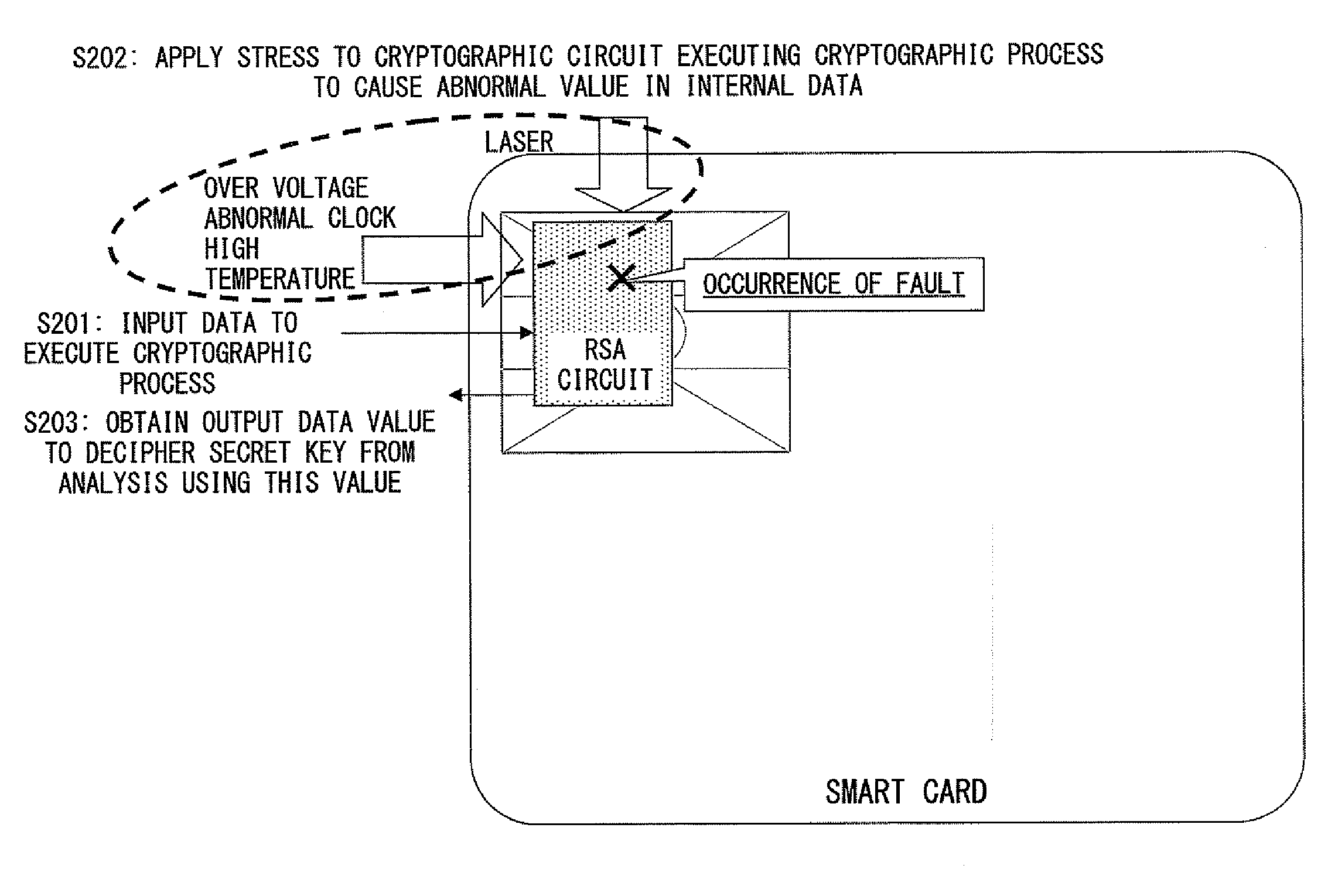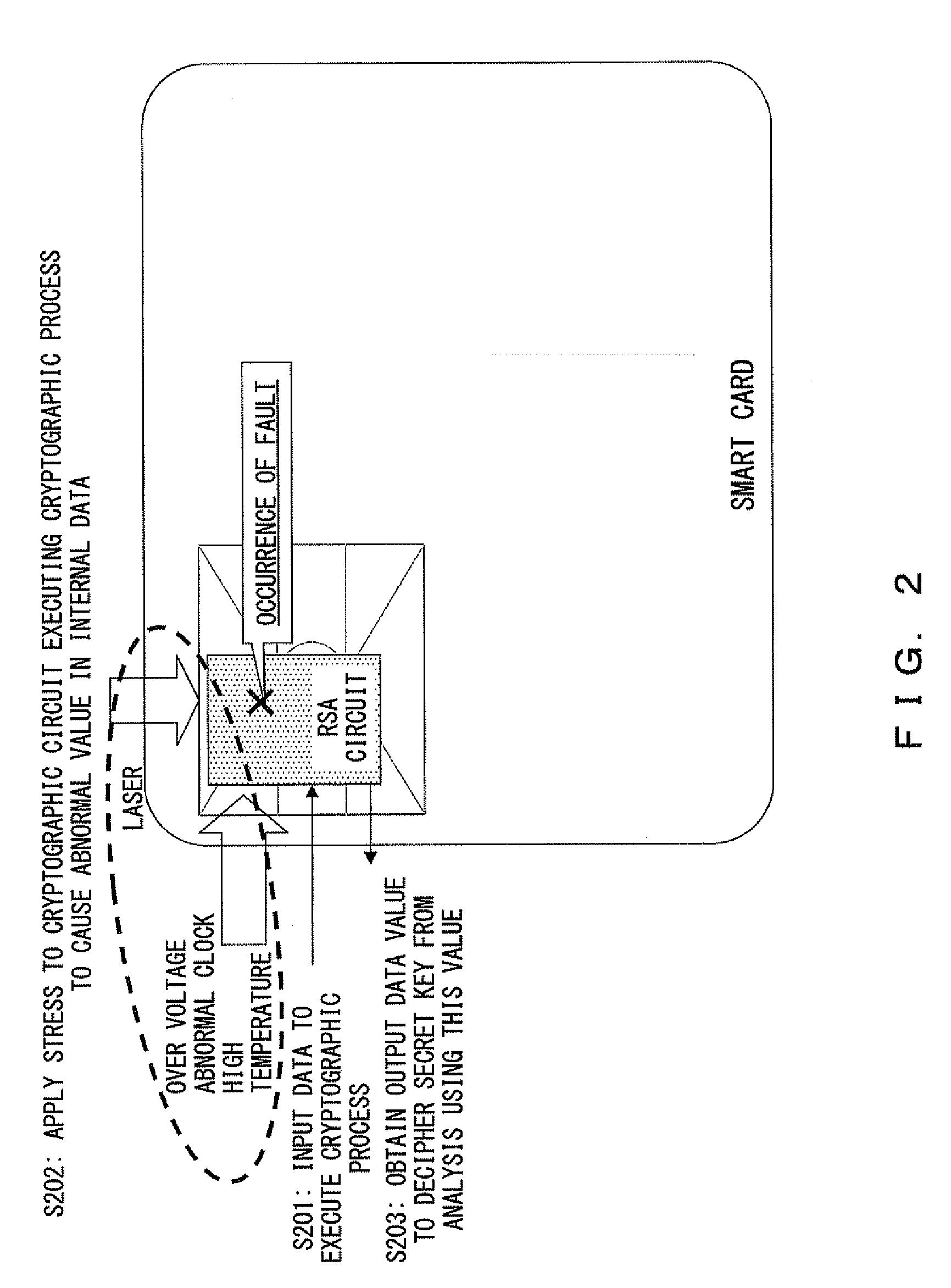Embedded device having countermeasure function against fault attack
a technology of fault attack and embedded device, which is applied in the field of embedded device having countermeasure function against fault attack, and the detection method of fault attack, can solve the problems of fault attack to public-key cryptography, large threat, and abnormal values in internal data, and achieve the effect of enhancing the security of cryptographic processing devi
- Summary
- Abstract
- Description
- Claims
- Application Information
AI Technical Summary
Benefits of technology
Problems solved by technology
Method used
Image
Examples
embodiment 1
Using Dynamic h′
[0104]The first embodiment of a fault detection algorithm according to the present invention will be described below as algorithm 8.
[0105]Input
s: f-bit integer
t: f-bit integer
r: r=2f
n: modulus of remainder, f-bit odd value
[0106]Output
REDC(s,t)=s×t×r−1 (mod n)
[0107]Multi-Precision Integers
s=(sg-1, . . . , s0)
t=(tg-1, . . . , t0)
n=(ng-1, . . . , n0)
y=(yg, . . . , y0)
n′=(n′g-1, . . . , n′0)
[0108]W-Bit Word Data, where r=2w.
tmp, c1, c2, h′
[0109]Algorithm
a801 y = 0;a802 for (j=0;ja803 (c1, tmp) = y0 + s0 × tj;a804 h′ = tmp × n′0 (mod 2w);a805 (c2, yNULL) = tmp + h′× n0 / * yNULL is always zero whenit is normal * / a806 if (yNULL != 0) return FAULT / * fault is detected toterminate algorithm * / a807 for (i=1;ia808 (c1, tmp) = yi + c1 + si × tj;a809 (c2, yi−1) := tmp + c2 + h′× ni;a810 }a811 (c2, c1) = C1 + C2 + yg;a812 yg−1 = C1;a813 yg = C2;a814 }a815 if (y>=n) y = y−n;a816 return y;
[0110]This algorithm 8 is an algorithm obtained when fault detection according to...
embodiment 1-1
Basic Circuit for Algorithm 8
[0112]FIG. 7 illustrates an example of implementing algorithm 8 in the form of a circuit. A circuit 700 in FIG. 7 includes multipliers 701 through 703, a fault detection circuit 704, and a memory circuit 705. The memory circuit 705 stores input / output data s, t, y, n, and n′0. The slash marks and letters put to the arrows for indicating the flow of data represent the number of bits of the data. This also applies to the circuit diagrams appearing hereinafter.
[0113]The multiplier 701 is a circuit for performing the multiply-addition-addition operations in steps a803 and a808 in algorithm 8. The multiplier 702 performs the multiply-addition-addition operations in steps a805 and a809 in algorithm 8. The multiplier 703 performs the integration in a804.
[0114]The fault detection circuit 704 is a circuit performing the fault detection in step a806, and it determines whether or not the values of the lower w bits of the result of the multiply-accumulation-accumula...
embodiment 1-2
Circuit for Algorithm 8 Including Buffer Configuration
[0115]The configuration of the circuit 700 described above is based on the multiply-addition-addition of w-bit×w-bit. This circuit configuration causes a problem of memory bandwidth.
[0116]The circuit 700 executes a process of reading (reading process) 5 pieces of w-bit data (s, t, y, n, and n′0) and a process of writing (writing process) one piece of w-bit data (y). In other words, the maximum data amount in the memory circuits being accessed in one cycle is 5w bits and w bits for a reading process and writing process, respectively. It is generally known that the greater the data amount accessed in one cycle in a memory circuit, the higher the cost of the memory circuit. A circuit configuration based on the multiply-accumulation-accumulation of 2w-bit×w / 2-bit is known as a configuration of a Montgomery modular multiplication circuit that solves the problem of access bandwidth (See Non-Patent Document 4 for detailed information).
[...
PUM
 Login to View More
Login to View More Abstract
Description
Claims
Application Information
 Login to View More
Login to View More - R&D
- Intellectual Property
- Life Sciences
- Materials
- Tech Scout
- Unparalleled Data Quality
- Higher Quality Content
- 60% Fewer Hallucinations
Browse by: Latest US Patents, China's latest patents, Technical Efficacy Thesaurus, Application Domain, Technology Topic, Popular Technical Reports.
© 2025 PatSnap. All rights reserved.Legal|Privacy policy|Modern Slavery Act Transparency Statement|Sitemap|About US| Contact US: help@patsnap.com



